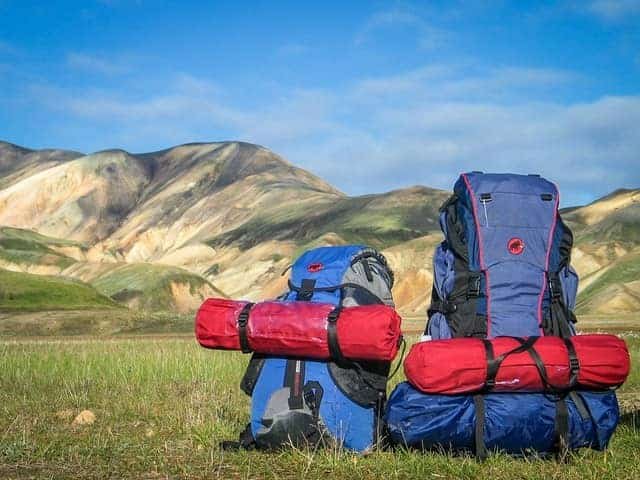With air travel shrouded in a lot of mystery for traveling hikers, it is only right to ask, are hiking backpacks allowed as a carry-on? Carryon luggage is what the airline authorities allow you to bring on the plane. Most outdoor lovers find themselves at crossroads regarding the safety and legitimacy of their luggage when it comes to traveling to their favorite hiking or backpacking destinations by air. Indeed, their worry is justified owing to the number of uncertainties that come with air travel, particularly for their usually colossal hiking backpacks.
There is always the constant worry about losing stuff, having their backpacks mishandled by baggage handlers and in worse scenarios, confiscated by airport security. However, that should not be the case. Boarding a flight to your dream spot no longer has to be scary and confusing. If you have ever wondered whether hiking backpacks are allowed as carry-on, then you should read on intently. This article unravels answers related to all your questions about traveling with your hiking backpack on an airplane. It offers useful insights and tips that might come in handy on your next trip.

Are Hiking Backpacks Allowed As Carry On?
Yes, but only if they are the right kind. Air travel is, without a doubt, the fastest means to get to your next big adventure. Unfortunately, it comes with endless changing rules regarding luggage size and allowance. That said, it is hard to ascertain whether your backpack is okay as a carry-on or you might have to check it in. The difference between the two types of luggage lies in the fact that the former is free while you will have to pay for the latter.
The final answer, in this case, will depend on airline regulations as well as the kind of backpack you bring along. Other than that, if your backpack is to be allowed as a carry-on then it must fit into an overhead compartment. Most airlines have space ideal for a backpack of up to 45L maximum. Thus it would be wise to have a backpack that falls under this limit. As for the dimensions, most airlines recommend measurements of not more than 22 by 14 by 9 inches. Flexibility is another aspect you will have to consider to bring your backpack on board. If the pack happens to have a rigid frame or it is simply not flexible enough for overhead compartments, you might have to think twice.
Can You Take Your Hiking Pack On A Plane?
Indeed you can, but only after thorough preplanning to ensure your luggage lives up to the requirements of your airline in terms of size limitation and weight. Having your backpack by your side on the plane gives you a little peace of mind as you get to keep a close eye on your belongings. Backpacks encompass lots of zippered side pockets that are easy targets for thieves. Having your backpack as a carry-on will also eliminate any damage that might be incurred in the course of the check-in process.
How to Protect Backpack When Checked As Luggage?

Anything is bound to happen to your precious backpack while in the hands of airport authorities. To avoid any damage from befalling your backpack, you can utilize the following tips:
1. Conceal or remove straps from your backpack
Straps and anything that dangles out is parts of a backpack that are most likely to get entangled in the baggage handling conveyer belt. Airplane-approved bags usually include a secret compartment where you can stash straps or anything that hangs out. Unfortunately, the same may not apply to that backpack you choose to check in as luggage. To keep them out of harm’s way and ensure your backpack remains intact, it might be wise to either remove the straps or ensure they are sufficiently hidden.
2. Add a rain protector to your backpack
Rain protectors provide an extra layer of protection regardless of how thin they are. What’s more, they are readily available at the airport. These rain protectors come in the form of plastic bags designed to keep moisture out of your luggage. They will pay off in this scenario by keeping the straps on your backpack safe.
3. Stick to TSA-approved locks
Another way to keep your backpack safe is to use TSA-approved locks. These locks can be opened only by TSA agents and are inaccessible to luggage handlers or other airport staff. An ideal backpack comes with big sturdy lockable zippers which are vital when you want to incorporate the locks. As much as the locks might not be entirely secure, they will cut down on the number of potential threats to your backpack. Using TSA-approved locks is a great way to mitigate theft when you need your backpack transported from one country to the next.
4. Mail your backpack instead
The chances that your backpack will be damaged irreversibly are quite minimal although shit does happen. To be on the safe side, it is advisable to mail your backpack instead. This way you can travel worry-free. It is particularly convenient for disallowed gear such as trekking poles. On top of that, your backpack will be much safer considering the level of packaging expertise synonymous with mailing services. You can rest easy knowing that your backpack will be in safe hands, sealed and encased in impenetrable heavy-duty plastic bags.
5. Confirm airline regulations on weight
This is where most hikers go wrong. It will be a complete waste of time to bring along overweight luggage and expect airline authorities to let you through. The first step to avoiding such inconveniences is to confirm that your backpack’s weight conforms to what the airline authority demands. Weight limits for checked bags vary from airline to airline. Hence, it would be wrong to assume that what was allowed for a previous one will work for the next airline. If your backpack is overweight, you might have to incur an extra $100 alongside the $25 you paid to have the bag checked. Of course, the charge will vary depending on your airline. Other airlines will simply not accept your overweight backpack on board.
Packing Your Backpack for a Carry On

Most airlines will only allow you to pack necessities in your carry-on bag. This includes food, water, and clothing as well as sundries like soap, sunblock, and deodorant. About 3.4 ounces of liquid at most is okay for many airlines. Insect repellent and roll-ons should not go beyond 100 milliliters. Apart from that, you are not allowed to pack firearms, hatched knives, and even trekking poles in your carry-on bag. Here are more tricks that will get you through clearance seamlessly:
a) Avoid travel backpacks
Most airlines allow up to 45 L in capacity which is an ideal size for a daypack. Travel backpacks are much bigger offering not less than 60 L in capacity. Also, they come with wheels and hideaway traps, which is cool. Nonetheless, they are too huge and inconvenient for backcountry adventure let alone air travel.
b) Switch your fuel stove for an alcohol stove
It is illegal to carry fuel on a plane. Do not even think about it. Instead, switch to an alcohol stove if you are worried about fuel. Ethyl alcohol, methylated spirit, or denatured alcohol can be found anywhere across the world and will surely be at your destination.
c) Leave your blades at home
Do not pack a machete, multi-tool, knife, or any form of a blade in your backpack if you want it to pass as a carry-on. TSA will be more than glad to take it away.
d) Pack light and small
Pack things that are most dear to you or those items that are costly. It could be your GPS, tent, sleeping bag, and so on. Less vital items like novels will only add bulk to your backpack and deny it free space on the plane. Rather than risk having your backpack confiscated or rejected overweight issues, it would be safer to ship extra food, novels, or prohibited stuff to your destination.
e) Pack your items in a single backpack
The last thing you want when traveling with an overstaffed backpack is to draw unnecessary attention. Having multiple packs will make you outstanding to airport authorities and bring more scrutiny.
f) Remove heavy accessories from the backpack at the check-in desk
A good number of airlines are generous enough to allow for an extra personal accessory. This could be in form of a laptop and so on. It would be wise to remove such accessories before handing in your pack at check-in. This will make the pack lighter and more proportionate since the weight of the extra item will be included in the weight of the entire carry-on pack if placed together. You can place it back once you are on board the plane.
g) Put on bulky shoes and clothes to lighten your backpack
Remember, that slightest weight beyond what is required by your airline will be costly. One way to keep such problems in check is to wear your heaviest clothes or shoes to have a lighter pack. Likewise, you can tie your bulkiest clothes around your waist until you get inside the plane.
h) Avoid prohibited stuff at all costs
This includes anything sharp or bladed as well as all flammable items. You are not allowed to bring any lighters, aerosols, compressed gas, camping gas cylinders, or paraffin bottles onto a passenger plane. The same goes for radioactive substances, alkalis, acids, and fire extinguishers. Sporting equipment like trekking polls is illegal too.

Other than adhering to the regulations on size and allowances, the key to having your backpack on board with you is to always keep it neat and well organized. Of course, you will have to conduct some background research on your airline to avoid packing prohibited items. Other than that, hiking backpacks are excellent travel bags that can double up as carry-on.




